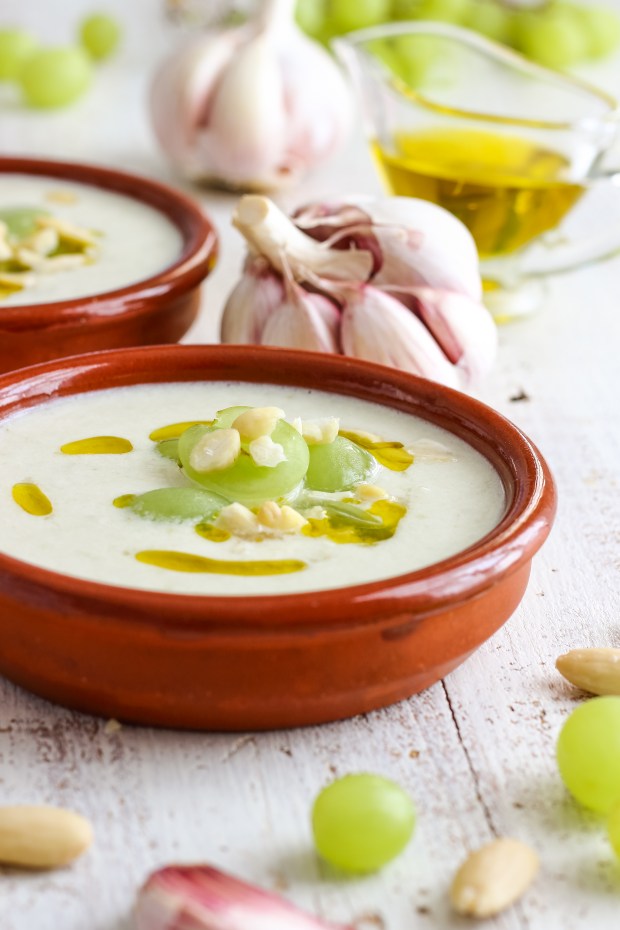I think we can all agree: Spanish food is delicious—infinite tapas, woody wine, garlic-infused everything. Yum. Yet mastering our cuisine is much more complex than throwing a couple of prawns on rice and calling it paella. To make Spanish food taste its best, one needs to understand the geography of the land, the history of the country, and the character of its people.
This is why I love gazpacho. To me, this vegetable soup is the epitome of Spanish gastronomy. How could such a simple dish embody centuries of culinary history? I’m glad you asked.
Let us start with the climate. Food is a product of its environment, and as every British retiree will be happy to tell you, the south of Spain enjoys gloriously warm weather. The southern region of Andalucía also boasts mountains, rivers, and fertile plains, making it ideal for the cultivation of every vegetable you can think of. It should come as no surprise then, that it was in this agricultural wonderland that gazpacho was born.
The origins of the dish, however, are hard to trace, since it was not the creation of some king’s private chef but of poor, ingenious farmers. Theirs was incredibly difficult work. Even during harvest season, rural villagers in southern Spain would often struggle to find enough to eat. Working from dawn to dusk under the unforgiving sun, these workers needed a quick meal that would provide them with enough salt and water to keep them going.
All they had was stale bread, garlic, and leftover veggies. So they pounded all of them together, and—olé—gazpacho was born. Still in southern Spain, gazpacho is considered the perfect working-class meal—especially when you add some extra bread and hard-boiled eggs, turning it into what’s known as salmorejo.

Yet gazpacho is more than just an industrious meal for sunstroke-suffering farmers. It’s also a liquid encapsulation of Spain’s history.
Let’s travel back to the 1st century A.D., when Spain was a Roman province. The biggest commodities at the time were wheat, olive oil, and grapes. Gazpacho still contains all three of these Mediterranean staples, in the form of bread, oil, and vinegar. Roman legions would carry garlic with them and mix it into the previously mentioned ingredients to make a nourishing (if smelly) porridge.
The ancestor of gazpacho is likely this white paste, later adopted and improved by Andalusian women, who would patiently pound all the ingredients in earthenware mortars, adding water until it turned into a refreshing soup. This version is called ajoblanco.
But isn’t gazpacho red? Well, yes. Yet tomatoes are indigenous to the Americas, not Europe. Spanish people never saw a tomato until the 16th century, when conquistadors returned from the New World with some of these shiny red fruits. As such, gazpacho represents not only Spain’s Roman roots but also its long imperial history.
Tomatoes didn’t catch on straight away, though. They were expensive rarities that most Spaniards found too watery and insipid to the taste. Italians began to use them first, and it wasn’t until the 19th century that they finally made their way into the gazpacho bowl.

In the 20th century, our humble tomato soup was exported around the world—a testament to Spain’s international outlook but also to its love of nouvelle cuisine. It’s now common to find versions of gazpacho containing all sorts of exotic ingredients, from watermelon to avocado. Nowadays, hipster chefs even make gazpacho ice creams and foams.
This brings me to my favorite ingredient in gazpacho: anarchy. We Spaniards are not the most rule-abiding of people. We enjoy breaking molds. We like to improvise. And we prefer to let our mood rather than a book guide our hand in the kitchen.
That’s why, despite being such a staple, there’s no go-to recipe for gazpacho. Or, to be more accurate, there are as many gazpacho recipes as there are grandmothers in Spain.
It truly doesn’t matter what Martha Stewart or Jamie Oliver might have to say on the subject of acidity and texture. For a Spanish person, the only measure of a good gazpacho is, Does it taste like that of my abuela?
Here’s where you will find all Spanish families swearing their version of gazpacho is the best. Some people add onion, while others swear exclusively by garlic. (My family is in the latter camp.) Some love using cucumber, while others are totally grossed out by it. Some even include carrot. God forgive them.
Recipes also vary according to region. Near Cadiz, residents like it as thick as a dip. In La Mancha, they add meat. Catalans prefer to top it with fried croutons, and in parts of Castilla, the soup is garnished with large vegetable chunks.
So how do you navigate the subtle differences in gazpachos when you are ordering it at a restaurant or trying to make some at home?
If you were not blessed with a Spanish abuela, you will have to taste many a vinegary concoction before you find your favorite recipe. But I believe this is a fabulous way to spend one’s time, so here are a few pointers: Use only the ripest tomatoes and a generous pour of olive oil. Soak the bread in vinegar before adding it. And if you want to have it warm, just don’t. Please. Don’t.
Gazpacho is the perfect example of what makes Spanish cuisine so great. It’s an homage to our weather, our Mediterranean roots, our colonial history, and our unruly spirit. Oh, and did I forget to mention? It tastes delicious.